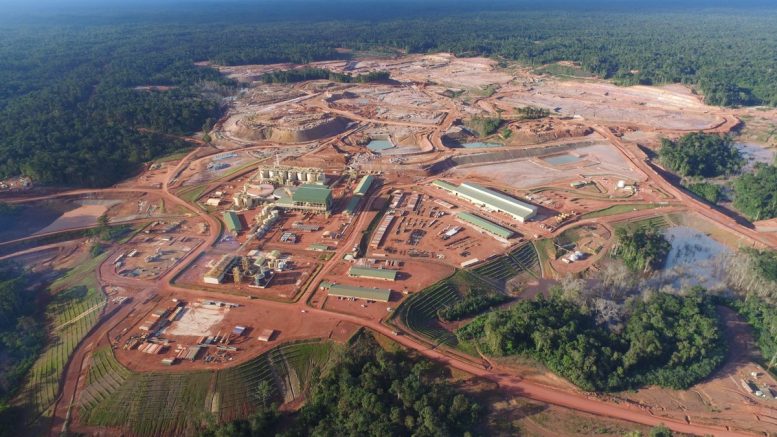The new year continues to be a fascinating one in the global mining industry, with the unveiling on Jan. 14 of Newmont Mining’s blockbuster US$10-billion deal to acquire Goldcorp, and regain top spot from Barrick Gold among global gold miners.
Barrick had entered 2019 on a roll, having completed its own US$5.4-billion acquisition of Randgold Resources in a kind of reverse takeover at the management level, with Randgold CEO Mark Bristow and his team taking the reins of the larger but somewhat adrift Barrick.
Barrick’s market capitalization stood at a gold industry-leading US$21.5 billion on Jan. 15, versus a combined US$25.4 billion for Newmont (US$16.5 billion) and Goldcorp (US$8.9 billion) on that day.
For Barrick and Newmont shareholders, this compares favourably with the market caps for the rest of the pack of major gold miners: Newcrest Mining, US$13.2 billion; Polyus Gold, US$10.7 billion (notably holding 68 million oz. in gold reserves, the world’s second-largest); Agnico Eagle Mines, US$9.2 billion; AngloGold Ashanti, US$5.2 billion; Kinross Gold, US$3.9 billion; Gold Fields, US$2.9 billion; B2Gold, US$2.8 billion; Yamana Gold, US$2.3 billion; and Iamgold, US$1.7 billion. (Russia’s Nordgold is no longer publicly traded.)
Still, a Newmont-Goldcorp will be dwarfed by the world’s three largest mining companies: BHP Group, US$114 billion; Rio Tinto, US$85 billion; and Vale, US$74 billion.
With the offer for Goldcorp being so large, the appearance of any rival bidder is unlikely, as Barrick stays busy optimizing its assets, and the base metal supermajors show zero inclination to increase their exposure to gold.
So, barring any further mega-merger in the mid-term, Barrick should retain the crown as world’s largest gold miner by market cap and gold production for around half a year, until the Newmont-Goldcorp deal closes.
After that, Newmont-Goldcorp is targeting sustainable production of 6 million to 7 million oz. gold annually from a reserve base in the neighbourhood of 121 million oz. gold. This compares with Barrick’s output, which will likely dip below 6 million oz. in 2020, if it goes through with its asset sales.
These projected output levels are well off Barrick’s all-time annual production record for gold miners of 7.7 million oz. gold in 2010 and 2011.
The view in the gold industry is that, with its takeover amid recent multi-year share price lows, Goldcorp is finally paying the price for overpaying for many acquisitions and for chronic underperformance in mine development and ramping up of new mines.
These are two problem areas that play to Newmont’s strengths as a careful allocator of capital and a technically savvy mine developer.
The biggest downside of the Newmont-Goldcorp deal is in the hearts of the Canadian mining industry, as it loses yet another head office and all its interesting and high-paying jobs, and spinoff effects, to yet another larger, foreign buyer.
The first wave of corporate hollowing-out was in the base metals sector, and it started last decade with the disappearances of Inco, Falconbridge and Alcan, plus steelmakers Dofasco and Stelco. The second wave — less than a year after Canadian nationalist and Barrick founder Peter Munk’s death — is now hitting the remaining gold-sector head offices, with Barrick’s head office presence cut to the bare minimum in Toronto, and Goldcorp’s Vancouver office to be turned into a Newmont regional office.
Most of the largest mining head offices still left in Canada are there only because of unusual circumstances: Cameco’s special national security status as a uranium producer; Nutrien’s prairie presence due to the federal government’s blocking of the sale of PotashCorp to BHP; Teck Resources’ B shares that prevented any hostile bid; and Lundin Mining’s strong connection to the Lundin family.
If there’s one certainty, it’s that the gold sector is ripe for more consolidation — particularly if Barrick and Newmont’s newest deals become as value-creating as advertised. We would look to AngloGold making bold moves this year as it seeks to cut all ties with its South African roots, and as new CEO Kelvin Dushnisky settles into his job and seeks to make his mark, and perhaps even to show up his former colleagues at Barrick, where he was effectively pushed out of a leadership role in mid-2018 to make way for Bristow’s ascendancy.



Be the first to comment on "Editorial: Newmont-Goldcorp merger rocks gold industry"